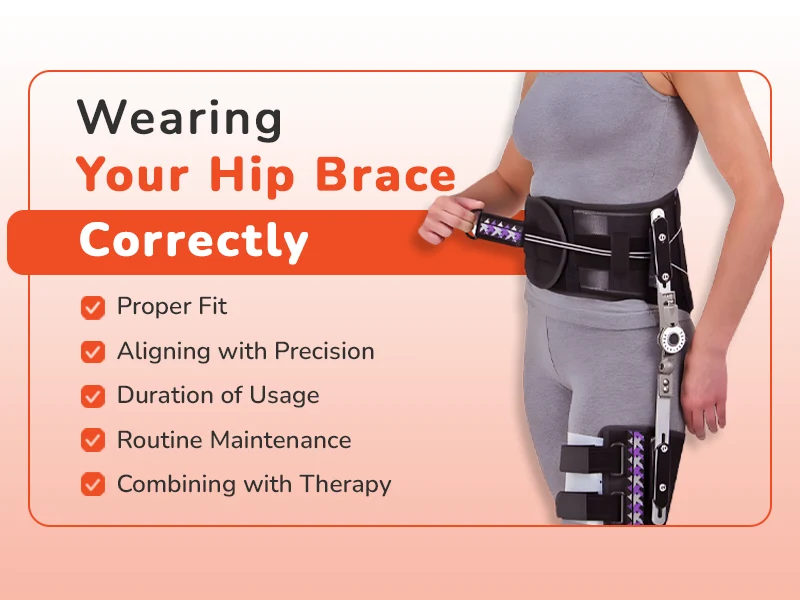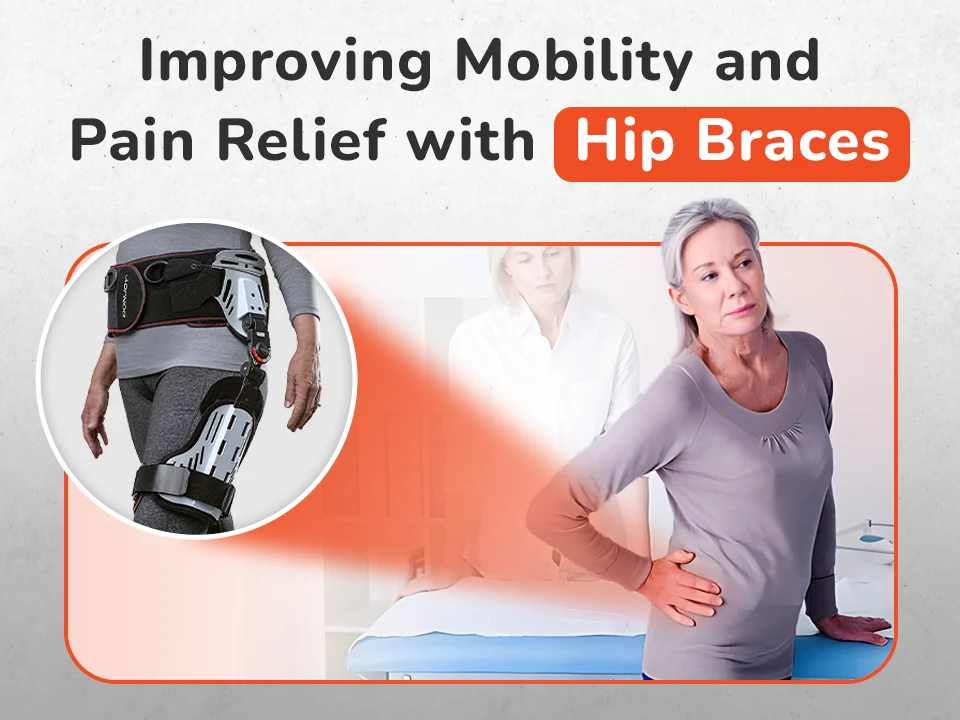Improving Mobility and Pain Relief with Hip Braces
Are you or a loved one grappling with the challenges of hip pain or restricted mobility? Hip braces have emerged as a valuable solution, promising renewed comfort and independence. This comprehensive guide will delve into hip braces, uncovering how they can significantly enhance mobility and provide much-needed relief from hip discomfort. Whether you’re dealing with age-related issues, recovering from surgery, or seeking support for an existing condition, hip braces offer a path toward a more active and pain-free life.
Understanding Hip Pain and Mobility Challenges
Before we dive into the world of hip braces, it’s essential to grasp the significant challenges posed by hip pain and reduced mobility. Hip issues can originate from various sources, including arthritis, injuries, or surgical procedures. Regardless of the cause, these conditions often result in discomfort, a limited range of motion, and difficulty performing daily activities. Hip braces step in as effective allies for individuals facing these formidable challenges.
Types of Hip Braces
Hip braces are not one-size-fits-all; they come in various types, each meticulously designed to address specific hip conditions and mobility needs. Familiarizing yourself with these different types of brace is crucial when selecting the perfect brace. Let’s delve into the following types:
- Compression Hip Sleeves: These sleeves provide gentle compression and support, making them ideal for individuals experiencing mild hip pain or discomfort. They offer subtle yet effective relief.
- Hinged Hip Braces: Distinguished by their hinges, these braces are a solid choice for more severe hip issues or those needing post-surgery support. The hinges enhance stability and control.
- Wrap-around Hip Braces: Designed with ease of use and adjustability in mind, these braces offer versatile support for various hip conditions. Their user-friendly design makes them accessible to a wide range of users.
- Trochanter Belts: Targeting the hip’s trochanter area, these belts provide localized support for specific hip problems. They offer precise and focused relief where it’s needed most.
Benefits of Hip Braces
The benefits of hip braces are multifaceted, making them invaluable aids for individuals grappling with hip pain and mobility challenges. These advantages encompass:
- Pain Reduction: Hip braces employ targeted compression and support, effectively reducing pain and discomfort in the hip area. They provide relief that can make a world of difference in daily life.
- Improved Mobility: Braces empower individuals to move more freely and comfortably by stabilizing the hip joint. Improved mobility fosters independence and a higher quality of life.
- Post-Surgery Support: Braces play a pivotal role in the healing process for those recovering after hip surgeries. They provide protection and stability, which are essential for a smooth recovery.
- Preventive Measures: Athletes or individuals at risk of hip injuries can proactively use braces during physical activities to minimize the chances of injury. Prevention is often the best strategy to maintain hip health.
By exploring the various types and understanding the manifold benefits of hip braces, you can embark on a well-informed journey to select the ideal brace tailored to your specific hip condition and mobility requirements. Whether you seek relief from pain, enhanced mobility, or preventive measures, hip braces are versatile companions in your pursuit of improved hip health and overall well-being.
Choosing the Right Hip Braces
Selecting the ideal hip brace is crucial in improving mobility and pain relief. It involves a thoughtful consideration of various factors, including the type of hip condition you are dealing with, your activity level, and your personal preferences. This section will provide essential insights and guidance on choosing the right hip brace tailored specifically to meet your unique needs.

- Understand Your Hip Condition: The first and foremost step is to understand your hip condition or why you need a hip brace. Hip braces can serve different purposes, such as supporting arthritis, stabilizing the hip joint post-surgery, or managing conditions like bursitis or tendonitis. A clear understanding of your condition will help you narrow down your options.
- Consult Your Healthcare Provider: It is highly advisable to consult with your healthcare provider, orthopedic specialist, or physical therapist. They can provide valuable insights into the type of brace most effective for your condition. They may also recommend specific features or brands based on their expertise.
- Consider Your Activity Level: Physical activity and lifestyle play a significant role in choosing the right hip brace. If you are an active individual, you may require a brace that offers support and flexibility, allowing you to engage in various activities. On the other hand, if you have a more sedentary lifestyle, a brace focused on providing stability and pain relief may be more suitable.
- Evaluate Brace Types: Hip braces come in various types, each designed for specific purposes. Some common types include compression hip braces, hip abduction braces, and hip stabilizers. Research and understand the features and benefits of each type to determine which aligns best with your needs.
- Comfort and Fit: The comfort and fit of your hip brace are paramount. Ensure that the brace you choose fits snugly but not too tight, as excessive tightness can lead to discomfort and skin irritation. Follow the manufacturer’s sizing guidelines meticulously to find the right fit.
- Ease of Use: Consider how easy it is to wear and remove the brace. If you have mobility issues or limited dexterity, choose a brace with user-friendly features like adjustable straps or simple fastening mechanisms.
- Material and Durability: Examine the materials used in the brace. Look for breathable and durable fabrics that can withstand regular use. A well-constructed brace will offer longevity and dependable support.
- Cost and Insurance: Lastly, consider your budget and whether your health insurance covers the cost of a hip brace. Some insurance plans may provide coverage for medically necessary braces, so it’s worth checking with your provider.
By carefully evaluating these factors and seeking guidance from healthcare professionals, you can confidently choose the right hip brace that aligns with your specific needs and preferences. Remember that a well-chosen hip brace can significantly contribute to your comfort, mobility, and overall well-being, making it a valuable investment in your hip health.
Wearing Your Hip Braces Correctly
Selecting the right hip brace is the beginning of your journey toward improved mobility and pain relief. Equally crucial is wearing it correctly to harness its full potential. This section will provide valuable insights and tips on ensuring your hip brace fits snugly and is positioned correctly for optimal support and comfort.

- Proper Fit: The foundation of using a hip brace effectively is ensuring it fits you correctly. A brace that is too loose might not provide the support you need, while an excessively tight brace can be uncomfortable and restrict your movement. Therefore, it is essential to follow the manufacturer’s sizing guidelines diligently. Remember, the right fit strikes a balance between support and comfort.
- Aligning with Precision: Positioning your hip brace accurately over the affected area is paramount. Whether you are dealing with hip pain, recovering from surgery, or managing a specific condition, aligning the brace precisely with your hip joint ensures that you receive targeted support where needed most. It’s like having a reliable companion by your side, ready to assist you in your mobility journey.
- Duration of Usage: Your healthcare provider or orthopedic specialist will guide you on the recommended duration for wearing your hip brace. It’s essential to adhere to these guidelines diligently. Wearing the brace for the prescribed amount of time each day ensures that you benefit from the consistent support it provides, ultimately contributing to your pain relief and improved mobility.
- Routine Maintenance: Like any valuable tool, your hip brace requires proper care and maintenance. Keeping it clean and in good condition prolongs its lifespan, prevents skin irritation, and maintains hygiene. Always follow the care instructions provided by the manufacturer to ensure that your hip brace continues to be a reliable companion on your journey to better hip health.
- Combining with Therapy: In many cases, using a hip brace alongside physical therapy exercises can yield even better results. Consult your healthcare provider or physical therapist for a tailored exercise plan that complements your brace usage. These exercises can enhance mobility, strengthen hip muscles, and improve overall well-being.
By following these essential guidelines for wearing your hip brace correctly, you can make the most of this valuable tool in your quest for enhanced mobility and pain relief. Remember that the right fit and precise positioning of your brace, combined with routine maintenance and possibly physical therapy exercises, can significantly improve your hip health and overall quality of life.
Read More: Understanding Hip Braces: Essential Insights for Pain Relief and Support
Consultation with Healthcare Professionals
While hip braces can be crucial in your journey to pain relief and improved mobility, healthcare professionals’ guidance is invaluable. These experts possess the knowledge and experience to provide personalized recommendations, ensuring you select the most appropriate hip brace for your specific condition. Furthermore, their insights extend beyond mere selection, encompassing vital advice on the correct usage of the brace, allowing you to harness its full potential in enhancing your hip health and comfort. Therefore, before embarking on your path to hip pain relief and enhanced mobility with a brace, consider consulting with healthcare professionals who can serve as your trusted allies.
Conclusion
Embracing a hip brace as a part of your daily routine can usher in a remarkable transformation in your quality of life. By offering relief from pain and enhancing your mobility, hip braces serve as versatile allies on your path to improved hip health and comfort. Whether recovering from hip surgery, managing a persistent condition, or proactively safeguarding against injuries, incorporating a hip brace can be a pivotal step towards a more active, pain-free, and fulfilling life.

